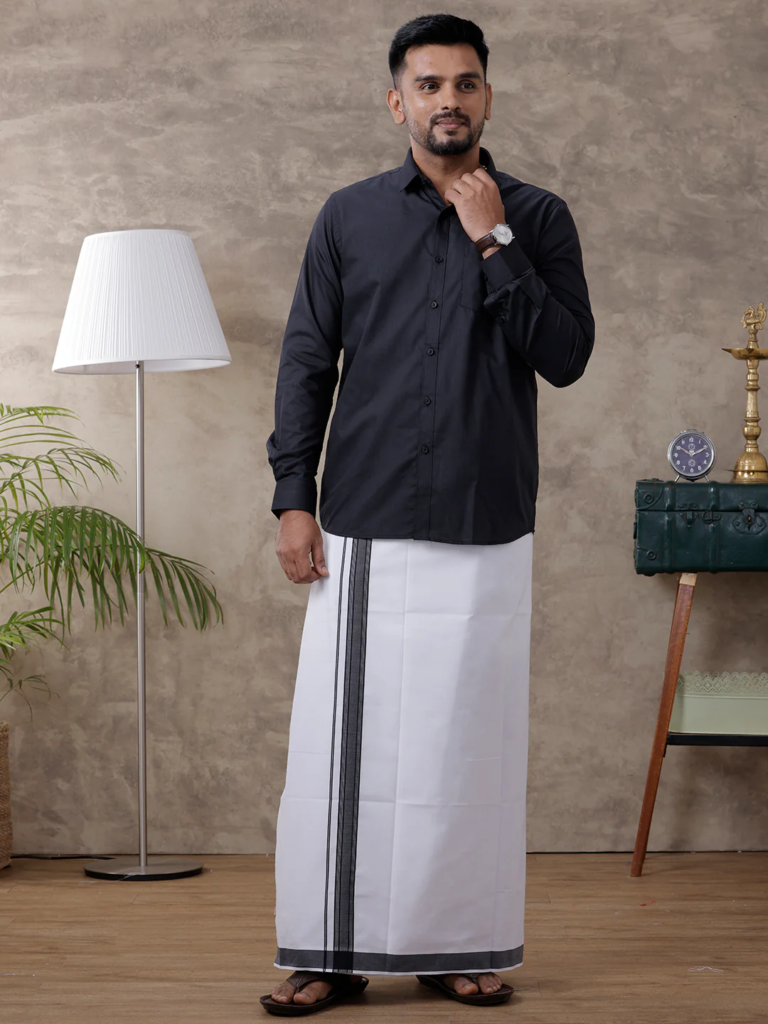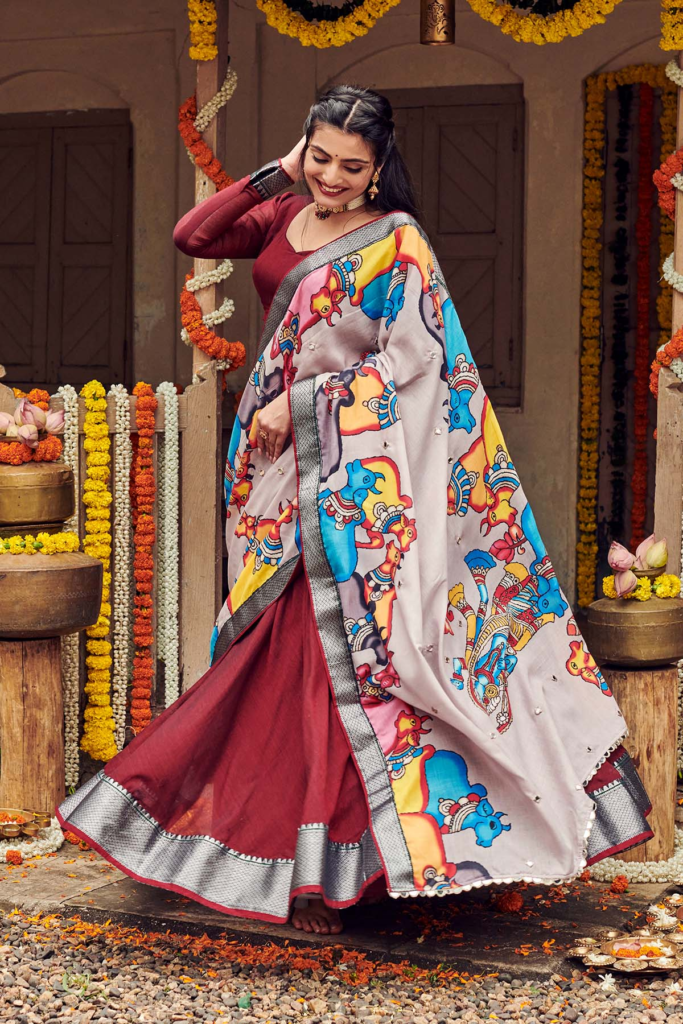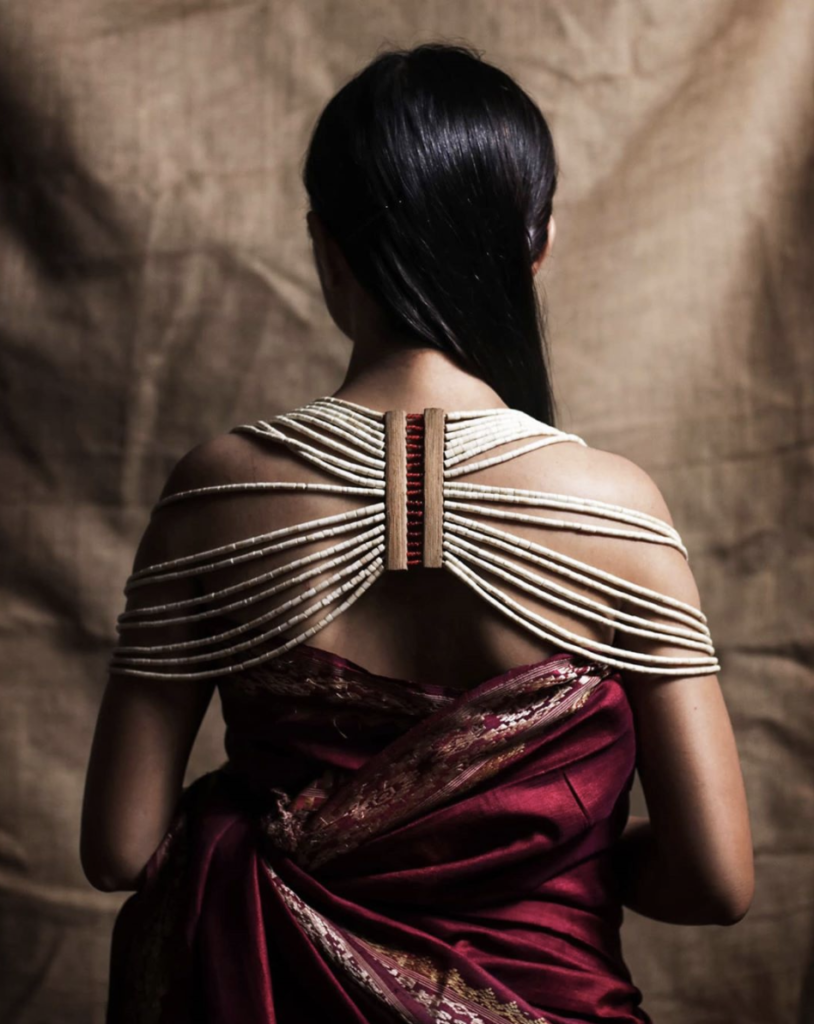Meghalaya is another beautiful state located in North-East India. This state is known for its rich biodiversity, traditions, and culture. People here love nature, respect it, and live a balanced and peaceful life. There are several tribes living in Meghalaya, each with its own rituals, culture, and traditions, which they love to showcase in their dress. These are considered the traditional dress of Meghalaya. Some popular tribes are Jaintia, Garo, and Khasi. The Garos are considered to be the most talented and skilful weavers in the state.
Let’s dive in to learn more about the traditional dresses of Meghalaya.
Traditional Dress of Meghalaya for Women
1. Jainsem

The women of the Khasi tribe wear this beautiful dress. It is a piece of cloth made using mulberry silk. Women of this tribe wear a blouse and a cotton shawl over it, known as tap-moh khlieh. A Jainsem covers the from the waist to the ankles.
2. Jainkup

Jainkup is mostly worn by the older women of the Khasi tribe. This piece of cloth is made of wool. It is worn with a full-sleeve blouse and a high neck. This elegant clothing is further accessorised with pure gold and silver jewellery.
These are also worn by them during special occasions, like Khasi festivals, especially during the celebration of Shad Suk Mynsiem.
During this festival, female dancers wear Jainsem and Jainkup with neckpieces made of red coral beads, further covered in foil, beaded jewellery in different colours and designs, golden earrings, and a golden or silver crown with silver threads at the back. This traditional dress of Meghalaya is made of two rectangular pieces of clothes, embellished with gold threads. The complete attire gives the dress an elegant and stylish look.
3. Dakmanda

Dakmanda is a small piece of cloth. This cloth is completely hand-woven and wrapped around the waist of Garo tribe women. This piece of clothing is similar to a lungi worn with a blouse. However, the traditional dress of Garo varies depending on where they live in a densely populated or remote area. This influences their way of dressing. In populated areas, they wear a long cotton dress, while in a remote village in the hills, they wear an eking. An eking is a small clothwhich woman wrapped around their waist.
4. Kyrshah

The primary source of income for 80% of the people of Meghalaya is agriculture. During the harvesting and post-harvest season, men of the Jaintia tribe wear a checkered garment on their head which is known as Kyrshah.
Women of this tribe during festival wear beautiful outfits with a velvet blouse and a sarong that reaches ankle length. Sarong is known as Thoh Khyrwang and has gold and silver ornaments and jewellery.
5. Mekhla

It is one of the most popular, stylish, and admirable traditional dresses of Meghalaya. This beautiful dress is woven using the fine Muga silk.
Traditional Dress of Meghalaya for Men
Jacket or Shirt and Dhoti

The traditional dress of Meghalaya for men includes a dhoti, a shirt and a jacket. The Dhoti is usually wrapped around the waist and between the legs to allow easy movements. During their festivals like Ka Pomblang Nongkrem, men also carry a sword with them. They also wear a beautiful turban made of silk for festivals and other occasions. The Garo tribe men wear a hand-woven loincloth.
Traditional Dress of Meghalaya for Weddings

The bride wears a traditional Khasi outfit; it is a Jainesem or a Dhara. This beautiful dress is made of yellow or saffron colour silk piece of cloth. The complete outfit includes several other clothing and jewellery.
The bride also wears a gold or silver crown with its peak attached to the back. This bridal outfit often has two pieces of contrast colour fabrics, worn on each shoulder. The complete outfit gives the bride’s body a cylindrical shape, making the bride look more beautiful and elegant.
The groom wears a traditional dress known as Jymphong, and a sleeveless coat. This dress features yellow lines, floral motifs and a symbol of a red cock with a v-shaped neck. It is tied at the front using Chinese frog fasteners. This outfit is made of deep blue colour decorated with silver or golden tassels at the bottom of the garment.
To cover the lower half of the body they wear a red coloured dhoti, called Jainboh. It is made of silk and has golden threads on its border. For such special occasions, even Khasi tribe men wear a turban known as a Jainspong. It comes in shades of yellow, red, and maroon.
Jewellery and Ornaments of Meghalaya
Traditional dresses of Meghalaya look more pretty with their creative jewellery pieces. Here are some of the beautiful ornaments:
1. Kynjri Ksiar

The women of the Khasi and Jaintia tribes wear this beautiful piece of jewelry. It is a 24-carat gold pendant worn especially during festivals and special occasions.
2. Paila

This is another piece of jewellery worn by the women of the Khasi and Jaintia tribes. This necklace is made of coral beads and gold, and it is known as Palia. It is a string of thick red coral beads, with hollow beads filled with lac.
3. Rigitok

This stunning necklace is worn by the people of the Garo tribe and is known as Rigitok. This piece of jewellery features a thin fluted stem of glass strung on fine thread. It is worn by both men and women of this tribe on special ceremonies.
4. Nadongbi nr Sisha

It is a brass ring worn around the earlobe by the Khasi and Jaintia tribes.
5. Ripok

The Garo tribe wears this necklace. It is made of long barrel-shaped beads of red glass, cornelian, brass, and silver.
6. Jaksil

It is an elbow ring worn by the rich men of Meghalaya during Gana ceremonies.
Checkout Traditional Dress of Delhi at Aking In.
Conclusion
Meghalaya is a beautiful state that never fails to showcase its love for culture, nature and traditions. With so many tribes residing here, each follows its own way of representing itself, which is visible in their outfits. Together, these outfits form the traditional dress of Meghalaya. They take pride in their rich culture and heritage, and their way of dressing is one way to express it. Even today, the women of Meghalaya can be seen wearing their traditional dresses on special occasions, like festivals or weddings.